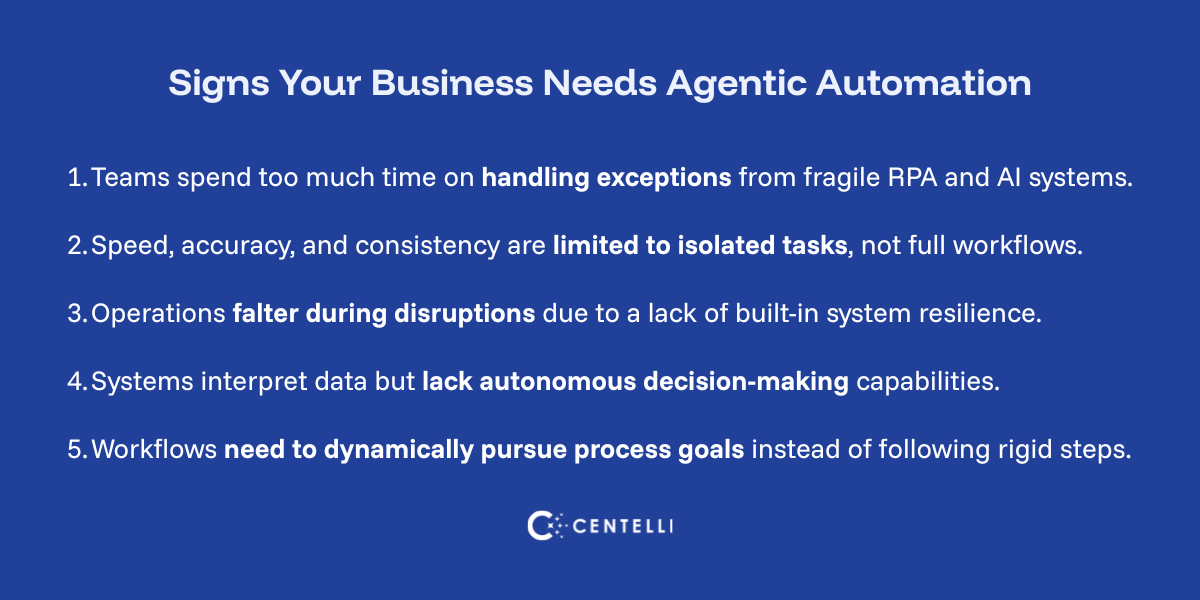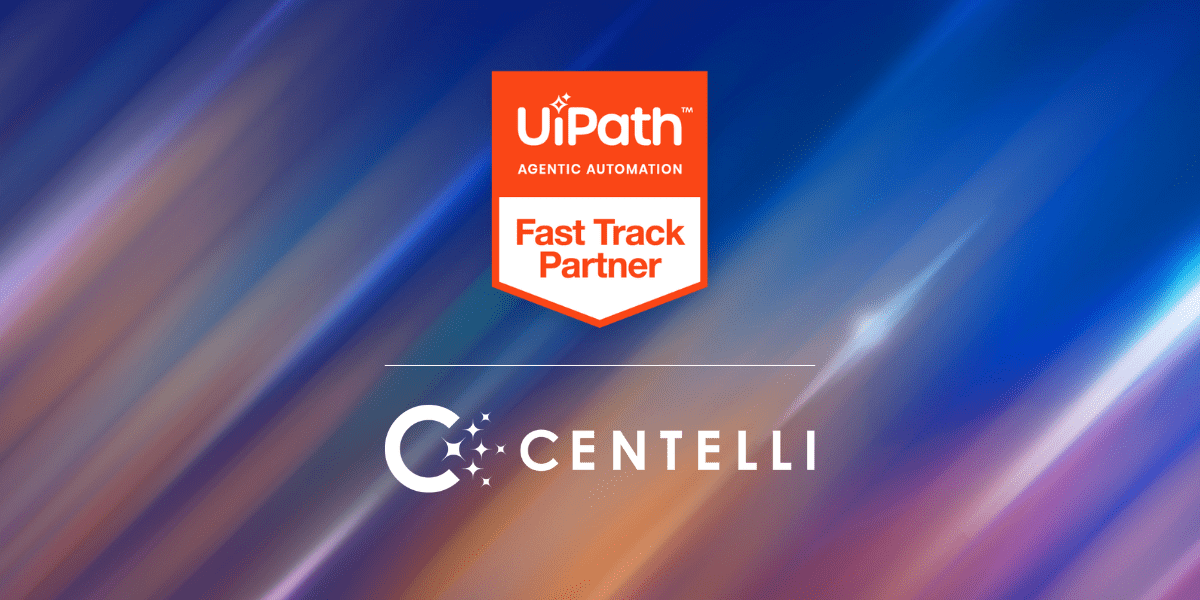
- Agentic Automation
- Written By Namita Bhagat
Agentic Process Automation: The Next Leap in Enterprise Automation
06-Nov-2025 . 6 min read
Is your organization ready to move beyond Robotic Process Automation (RPA) and Intelligent Automation (IA)? Agentic Process Automation (APA) could be your next strategic step in enterprise automation, combining the reliability of RPA with the adaptive intelligence of AI.
- Through RPA, many organizations have already captured tangible wins by automating high-volume, rule-based tasks for speed and accuracy
- Many have since advanced to AI-powered automation, creating intelligent processes that are faster, more accurate, and require less human intervention.
While these advances are powerful and relevant, business environments and operational demands continue to evolve. The next leap isn’t about simply adding intelligence to a task — it’s about building truly autonomous systems, where bots give way to AI agents that can complete tasks without human assistance.
What Is Agentic Process Automation and Why It Matters
Business success and growth depend on navigating operational complexities, managing costs and resources, and adapting to constant change. Technology plays a critical role in addressing these challenges, but it evolves.
Even though automation has been around for over a decade, new breakthroughs continue to emerge. So, legacy automation tools may provide limited benefits, leaving gaps in workflows and operations leading to inefficiencies and operational challenges.
Consider these examples:
- Your RPA bot may process a purchase order without errors, but if a vendor suddenly changes banking details or a compliance rule fails, the bot halts, requiring manual intervention.
- Similarly, even when your AI-powered document processor achieves 95% accuracy, the remaining 5% still requires exception handling and human validation.
What does that mean?
Well, your accounting staff, for instance, may be freed from manual data entry and reconciliations as RPA or digital worker bots take over, yet they still need to intervene for exception handling. This can become tedious, especially when dealing with large volumes of data /processes and multiple systems.

APA, however, unifies the best of RPA and AI into a layered automation spectrum, where deterministic, interpretive, and adaptive agents coexist to achieve seamless orchestration.
This means an entire task or process can be executed autonomously by more advanced software, without “human-in-the-loop”. As a result, operational teams are no longer stuck handling low-value tasks!
The concept of ‘Agency’ in Autonomation: It’s the capacity of a system (the Agent) to act independently, make decisions, plan its own steps, and adapt to achieve a defined, high-level goal, with minimal or no human intervention.
Notably, in most cases, APA is not meant to replace RPA or AI-powered automation.
Both of these approaches retain their distinct utility within active systems and lower-level processes, while APA operates on top. Alternatively, APA can also function independently for entirely new, complex workflows designed to bypass the RPA layer entirely.
Ultimately, it depends entirely on the organization’s automation needs and strategy.
How Agentic Process Automation Drives Strategic Advantage
Does every business need agentic automation? The simple answer is ‘no’.
The goal for leveraging any business technology is to deploy the simplest, most stable solution that effectively solves the problem. For many companies, RPA and standard AI-powered automation are enough for core, repeatable functions.
However, agentic automation becomes essential when competitive advantage depends on managing deep complexity, exceptions, or end-to-end orchestration. Consider these scenarios:
1. High Adaptability for Complex Workflows
Some processes demand reasoning to determine the next logical step. Example: A tax accountant reconciling multi-currency payments across diverse tax codes, requiring data synthesis from multiple systems. This is a task APA agents can manage autonomously.
2. Goal-Driven, Flexible Enterprise Processes
When outcomes matter more than specific steps. Example: An automotive retailer managing end-to-end vehicle delivery and financing workflows, where the agent dynamically adjusts actions based on inventory availability, customer preferences, and financing approvals.

3. Overcoming Fragile Systems to Scale Operations
If your system environment changes frequently and your workflows have frequent exceptions. Example: A hotel chain processes bookings across multiple properties, room types, and dynamic pricing structures. Here, an agent can autonomously handle cancellations, upgrades, and regulatory compliance adjustments.
In essence, agentic process automation is necessary when processes require judgment, reasoning, dynamic adaptation, and stability.
But RPA and Intelligent Automation can be enough if …
- Tasks are highly stable and deterministic
Example: Purely rule-based, structured, and repetitive tasks like generating daily performance reports or sending fixed-format emails.
- Unstructured data fits into a fixed workflow
Example: Intelligent document processing or OCR extraction where post-processing logic is pre-defined.
So, if your enterprise operations primarily meet these conditions, RPA or AI-powered automation suffice. But if the workflows have evolved beyond this threshold, it’s time to level up with agentic automation!
The Core Value Proposition of Agentic Workflows
The hallmark of APA is adaptive resilience, i.e., the ability to self-adjust when conditions change. Here’s a real-world example comparing how RPA, AI-assisted automation, and APA respond to a vendor management process challenge.
| Vendor Admin Task | Challenge | System Response | |
| RPA | Enter a new vendor’s name and bank details from an Excel sheet into accounting system. | System field label changes from “Bank Name” to “Financial Institution.” | Bot stops because the fixed script cannot locate the field |
| IA | Extract vendor tax ID and address from a PDF contract. | Tax ID matches fail against regulatory data. | AI-powered bot/ Digital Worker stops and routes to a human review queue |
| APA | Perform compliance checks /updates for a vendor partner | Domain name mismatch detected during security check. | AI Agent looks up public records for historical name changes, updates records, or autonomously emails vendor for correction |
Here is another illustration of agentic automation in action for a customer service process:
| Customer Service Task | Challenge | System Response | |
| RPA | Send a fixed email response for password reset requests. | Customer email subject line changes slightly or missing key term. | Bot cannot match template trigger; request is missed. |
| IA | Classifying customer emails and routing to correct department. | Model misclassifies an urgent complaint as a general query. | Routes message incorrectly; human correction required. |
| APA | Resolve Customer Query to Satisfaction. | Message contains unclear sentiment and mixed issues. | Agent analyzes context, identifies urgency, drafts empathetic response, routes issue to appropriate system, and confirms closure autonomously. |
Key Takeaways:
- APA transitions from ‘Rules to Reasoning.’ It doesn’t follow a preset path — it thinks, acts, adapts to complete a given goal, and continues to learn and retrain itself.
- Dynamic, context-aware reasoning is what makes APA a game-changer for enterprise automation resilience.
The Question Now Is …
All three tiers of automation offer distinct advantages.
While RPA and intelligent automation deliver proven gains in efficiency, accuracy, and throughput, agentic process automation unlocks a new form of ROI—one rooted in resilience, continuity, and adaptive intelligence.
Hence, ‘agentic’ gives organizations a clearer view of their strategic impact, enabling faster resolutions, reducing reliance on manual intervention, and strengthening operational resilience.
The question now is: Which level of automation maturity best aligns with your organization’s strategic vision? Are you ready to take the next step and embrace agentic automation? We can help!
As a trusted UiPath partner, we’ve helped organizations across industries transform their business through automation. Drop us an email or book a free call today to get started.




